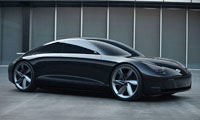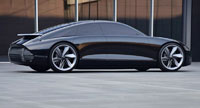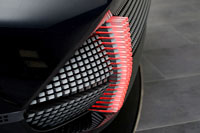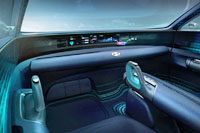
As new vehicles are turning into little more than rolling computers for transporting people and their gear, they’re in fact becoming less complicated than their predecessors, at least from a driving and styling perspective.
Hyundai’s new Prophecy Concept EV is a good example of minimalism meets modern-day tech thanks to the automaker’s new Optimistic Futurism design language that’s been created with the purpose of connecting consumers more completely with their vehicles, or so says the head of Hyundai’s global design center, SangYup Lee, as part of the electric’s car’s press release.
“We have brought to life yet another icon that establishes a new standard for the EV segment as well as pushing Hyundai’s design vision to even broader horizons,” commented Lee. “A part of that expansion is what we call Optimistic Futurism, a design concept embodied by ‘Prophecy’. With Optimistic Futurism, our aim is to forge an emotional connection between humans and automobiles.”

Developing emotional ties between buyers and products is a top priority of every effective brand, and this in mind Hyundai should do well with whatever comes of its new Prophecy, or at least the design language behind it. With the Prophecy, the Korean automaker’s namesake brand has created a styling exercise that’s both retrospectively minimalist and brilliantly detailed, resulting in a look that pulls cues from some iconic rivals, yet sets off on its own course too.
Yes, the complex curves that make up its outward design could have just as easily been concocted by Porsche for a future Panamera or even the new Taycan EV, not that it appears like either, but this said few automakers dare attempt to style a car with as many rounded edges as Porsche, let alone a grille-less front end like Tesla’s Model 3.
This said its seemingly vented rear end styling, which pulls attention from the large transparent acrylic rear wing resting above, reminds of the post-war Tucker 48, also particularly aerodynamic for its time, while mixed in with its pixelated 3D elements are LEDs for a set of protruding tail lamps. A similar pattern can be seen in the headlamp clusters up front, which use the same transparent acrylic as the rear spoiler and in the camera monitoring system, but the two headlights look a great deal more conventional than the eye-catching taillight design.

All of the features above improve aerodynamics, of course, which is why forerunning EVs have chosen their own unique variations of the Prophecy’s familiar design theme, but Hyundai’s propeller-inspired alloy wheels, which direct air down each side of the car’s body, are unique.
Hyundai hasn’t released any exterior or interior dimensions, but an open set of clamshell doors makes its mid-size four-door coupe layout clear, while the only available technical specifications depict a 100-percent electric power unit with a battery housed under the passenger compartment floor. Therefore, we expect it will ride on a completely new architecture that could provide multiple body styles on top.
The Prophecy’s interior features tartan-patterned upholstery that pays yet more homage to Porsche, particularly its 1975-1980 911, 924 and 928 models with blue-green being a popular colour combination at the time, yet nothing the Stuttgart-headquartered performance marque has ever done managed to achieve the eyeball-popping wow factor of Hyundai’s new creation, and not only because the South Koreans use the aforementioned Scottish kilt pattern for the seats’ side bolsters as well as their central insets.

The Prophecy’s sizeable wraparound digital display, which frames the windshield’s base, isn’t all that impressive these days either, but the pop-out primary instrument cluster is, yet even that won’t upstage the car’s driving controls. Obviously missing is a steering wheel, which has been replaced by a pair of pivoting joysticks, this ode to gaming apropos in a car that’s designed to be driven autonomously.
Of course, we won’t ever see the Prophecy on the road, its existence designed only to show new car buyers that Hyundai has an exciting future styling direction. If produced as is, we think Hyundai would have a hit in their hands.
Hyundai | “Prophecy” Concept EV Unveiling (16:04):
Story credits: Trevor Hofmann
Photo and video credits: Hyundai
